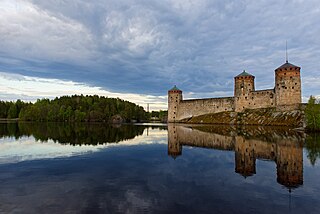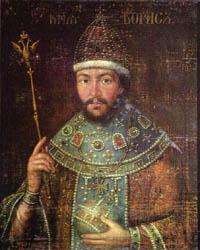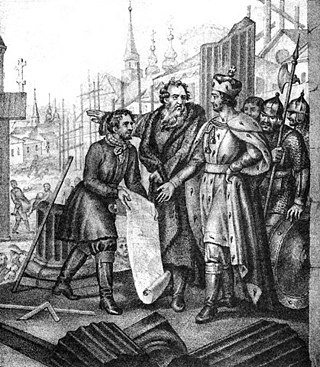This is a list of wars between Russia, Sweden and their predecessor states.

Magnus Eriksson was King of Sweden from 1319 to 1364, King of Norway as Magnus VII from 1319 to 1355, and ruler of Scania from 1332 to 1360. By adversaries he has been called Magnus Smek.

Olavinlinna is a 15th-century three-tower castle located in Savonlinna, Finland. It is built on an island in the Kyrönsalmi strait that connects the lakes Haukivesi and Pihlajavesi. It is the northernmost medieval stone fortress still standing. The castle forms a spectacular stage for the Savonlinna Opera Festival, which was held for the first time in the summer of 1912.

Karelians are a Finnic ethnic group who are indigenous to the historical region of Karelia, which is today split between Finland and Russia. Karelians living in Russian Karelia are considered a distinct ethnic group closely related to Finnish Karelians, who are considered a subset of Finns. This distinction historically arose from Karelia having been fought over and eventually split between Sweden and Novgorod, resulting in Karelians being under different cultural spheres.

The Shlisselburg Fortress or Oreshek Fortress is one of a series of fortifications built in Oreshek on Orekhovy Island in Lake Ladoga, near the modern city of Saint Petersburg in Russia. The first fortress was built in 1323. It was the scene of many conflicts between Russia and Sweden and changed hands between the two empires. During World War II, it was heavily damaged. Today it is part of the UNESCO World Heritage site Historic Centre of Saint Petersburg and Related Groups of Monuments.

The Russo-Swedish War of 1495–1497, known in Sweden as the Stures' Russian War, was a border war which occurred between the Grand Duchy of Moscow and the Kingdom of Sweden. Although the war was relatively short, and did not lead to any territorial changes, it has significance as the first war between Sweden and Moscow. Sweden earlier fought wars against the Novgorod Republic, before Novgorod was formally annexed to Moscow in 1478.

The Russo-Swedish War of 1554–1557, considered a prelude to the Livonian War of 1558–1583, arose out of border skirmishes. It ended when the parties agreed on a truce in the Treaty of Novgorod (1557).

The Russo-Swedish War of 1590–1595 was instigated by Boris Godunov in the hope of gaining the territory of the Duchy of Estonia along the Gulf of Finland belonging to Sweden since the previous Livonian War. As soon as the Truce of Plussa expired early in 1590, a large Russian army led by Godunov and his sickly brother-in-law, Feodor I of Russia, marched from Moscow towards Novgorod. On 18 January they crossed the river Narva and laid siege to the Swedish castle of Narva, commanded by Arvid Stålarm. Another important fortress, Jama (Jamburg), fell to Russian forces within two weeks. Simultaneously, the Russians ravaged Estonia as far as Reval (Tallinn) and Finland as far as Helsingfors (Helsinki).
The Swedish–Novgorodian Wars were a series of conflicts in the 12th and 13th centuries between the Novgorod Republic and medieval Sweden over control of the Gulf of Finland, an area vital to the Hanseatic League and part of the trade route from the Varangians to the Greeks. The Swedish attacks against Orthodox Russians had religious overtones, but before the 14th century there is no knowledge of official crusade bulls issued by the pope.
The Russo-Swedish War of 1656-1658, known as the War of Rupture, was fought by Russia and Sweden as a theater of the Second Northern War. It took place during a pause in the contemporary Russo-Polish War (1654–1667) as a consequence of the Truce of Vilna. Despite initial successes, Tsar Alexis of Russia failed to secure his principal objective—to revise the Treaty of Stolbovo, which had stripped Russia of the Baltic coast at the close of the Ingrian War.

The Third Swedish Crusade to Finland was a Swedish military expedition against the pagan Karelians from 1293 to 1295 in which the Swedes successfully expanded their borders eastwards and gained further control of their lands in Finland.

The Second Swedish Crusade was a military expedition by the Kingdom of Sweden into Tavastia c. 1249–1250 as described by the Erikskrönikan. As described by the Erikskrönikan, the Swedes defeated the Tavastians under the leadership of Birger Jarl.

The Finnish–Novgorodian wars were a series of conflicts between Finnic tribes in eastern Fennoscandia and the Republic of Novgorod from the 11th or 12th century to the early 13th century.
Truce/Treaty of Vilna or Truce/Treaty of Niemieża was a treaty signed at Niemieża near Vilnius on 3 November 1656 between Tsardom of Russia and Polish–Lithuanian Commonwealth, introducing a truce during the Russo-Polish War (1654–67) and an anti-Swedish alliance in the contemporaneous Second Northern War. In return for ceasing hostilities and fighting Sweden alongside Poland–Lithuania, the treaty promised Alexis of Russia succession in Poland after John II Casimir Vasa's death. The Cossacks under Bohdan Khmelnytsky were excluded from the negotiations, and subsequently supported the Transylvanian invasion on the Swedish side.

Finnish-Hungarian relations are the bilateral relations between Finland and Hungary. Both countries are members of the European Union, Council of Europe, NATO, and the Organization for Security and Co-operation in Europe. Both people’s language are part of the Finno-Ugric language family. In March 2023, Hungary fully approved Finland's application for NATO membership. There is minor tension in Finno-Hungarian relations at the advent of the Russo-Ukrainian and the Russo-Georgian wars, as Finland places themselves as staunchly against Russia in these conflicts, where as Hungary is far more neutral.

The Aminofffamily is a Swedish-Finnish noble family of Holy Roman and Russian origin. The family has produced statesmen, officers, academics, merchants, industrialists, and landowners. The Aminoff family is known for its active participation in commerce and industry.

The Attack on Åbo was a Novgorodian attack on the then Swedish city of Åbo in 1318, the Novgorodian goal of capturing the city failed, but they managed to burn the outskirts.